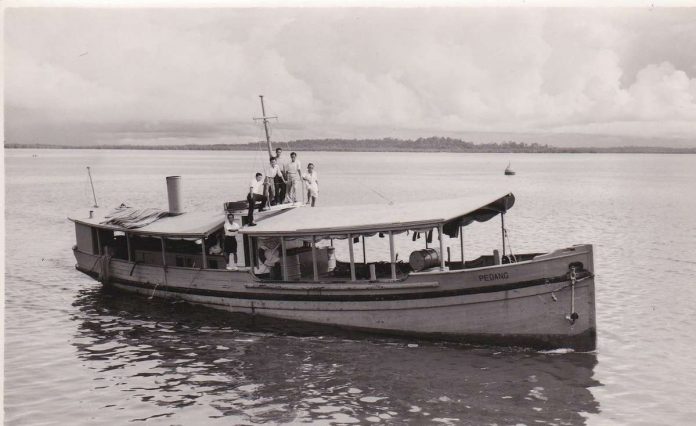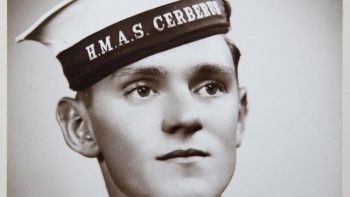
By Peter Hore
Able Seaman ‘Moss’ Berryman, who had died aged 96, was the last survivor Operation Jaywick, perhaps the most long-ranged and daring special forces raid of the Second World War.
On April 7, 1942, as soon as he was able, Berryman volunteered for the Royal Australian Navy. He and his friend, Able Seaman Fred Marsh, were still under training in Melbourne when they heard that a British officer was looking for volunteers to do something special.
‘A few days later, we were told to pack our bags, we were leaving the navy depot, and we were going to a commando school at Frankston. They taught us a few things that they teach commandos and then at the end of a few weeks, we found ourselves on the Sydney express that night. We were taken out to the Hawkesbury River to a quiet little bay, Refuge Bay, and we landed on the beach there amongst a great heap of tents and camp stretchers … and cooking utensils. Our instructions were to get all this stuff up to the top of this dirty great big cliff. We were told the quicker you get the tent up, and the quicker you get your bed made, the quicker you can have a feed”. They discovered that they were members of Z Force, commanded by Harrow-educated Major Ivan Lyon, and part of Special Operations Australia, formed to operate behind Japanese lines in South East Asia. “My mate and I looked sideways at each other. We were basically Sunday school boys. We had no idea how we were going to learn to kill people”.

However, on September 2, 1943 Berryman, now a fully trained commando, with seven other British and Australians under Lyons’ command, and six boat’s crew sailed north from Exmouth Gulf, Western Australia in the 70-ft former Japanese fishing vessel Kofuku Maru, now name Krait, after a small poisonous snake. Only once at sea did Lyon tell them that they were off to Singapore, some 3,500 miles away, “to blow up a few ships”. Berryman knew that the Japanese did not have a reputation for treating prisoners well, but “we were young ones, we thought we were indestructible, just like they do today”, and Lyon maintained morale by insisting “this isn’t dangerous, it’s exciting”.
“Still”, recalled Berryman, “I think if we had known earlier some of us may not have volunteered. There were definitely times we thought, what the Hell are we doing here? We’re getting five bob a day for this?”
The two-week voyage though Japanese-occupied waters was uncomfortable: inside Krait “was as bare as a baby’s bottom”, most space was taken up by fuel drums, they flew the Japanese flag and, posing as Malay fishermen, they wore sarongs and constantly applied foul-smelling brown dye to their skin. Berryman spent much time at the top of the mast with binoculars looking out for other craft, which would be given a wide berth. When, occasionally, a Japanese float plane flew over, members of Z Force would wave and stand in a circle pretending to unpick fishing lines.
On 18 September, Krait arrived off Singapore, which was ablaze with lights and where the Japanese thought themselves safe, and offloaded six commandos in three two-man canoes. Much to their disappointment, Berryman and Marsh were told to stay behind. “Of course, we put on a bit of a turn, ‘We’ve done all the training, sir, why can’t we be in it?’ And he said, ‘Nope, you two are going to be baby sitters and look after Krait’ ”. The canoeists established a base in a cave on a small island, and the night of September 26, paddled into the harbour to attach limpet mines to seven vessels, sinking or damaging 37,000 tons of shipping. Meanwhile, Krait loitered at sea for two weeks, until going to a rendezvous at the island of Pompong, 50 miles off Singapore, on the night of October 1-2, when only one canoe was found. Lyon had told Krait to leave that night no matter what, but “being good old Australians, we decided we’d break the law and go back in two nights later”, when the other two canoes were recovered.
On the return voyage, a few minutes to midnight on October 11, a Japanese patrol boat intercepted Krait in the Lombok Strait. As Berryman crouched low with his Bren gun trained on the warship, Lyon, who had packed Krait’s bows with high explosive, prepared a suicide ramming which would have destroyed both vessels, but, after the longest 15 minutes of Berryman’s life, the warship drew away without switching on a searchlight or hailing Krait: “It was pure luck”.
Krait entered Exmouth Bay after a 48-day mission. Berryman was mentioned in despatches for gallantry, skill and devotion to duty in a hazardous enterprise.
When later in 1943 Lyon asked Berryman whether he would care to return to Singapore as part of a larger, repeat operation, he carefully considered the proposal for two seconds before declining. On this second operation, Rimau, all were killed in action or executed by the Japanese. Instead Berryman completed his war service in the destroyer HMAS Vendetta , and was demobbed in February 1946.
Mostyn Berryman was born at Kent Town, South Australia, and brought up a Methodist: his father had fought as a teenaged signaller in the Australia Imperial Force on the Western Front in the First World War.
Postwar he returned to the stockbrokers S C Ward & Co, where he had been a clerk, and remained there until retirement 46 years later.
Berryman was aboard Krait when she entered Sydney in 1964 to become a museum ship, and in 1993, on the 50thanniversary of Operation Jaywick, he met Lyon’s son, “the spitting image of his father” at Kranji War Cemetery. Lyon’s French wife, Gabrielle Bouvier, and their baby son had spent the war in Japanese internment camps, and together Berryman and the son cried that the son had never met his heroic father.
For many years he was owed the five-bob-a-day danger money which he had been promised, and which. when the government did pay, was topped up to A$5,000.
Operation Jaywick, one of the most successful clandestine raids in Australian history, left a bitter aftermath. Lyon had intended that Jaywick be publicised to rattle the Japanese and boost Allied morale, but senior commanders decided against this as they wished to conduct similar raids in the future. Not having the slightest idea of how the attack had been mounted, the Japanese inflicted savage reprisals on Singaporeans, who they suspected of aiding the attack. “Sometimes”, a troubled Berryman mused in later life, “I feel that we shouldn’t have done it because they murdered untold number of people trying to find out who did.”
He married his childhood sweetheart, Mary Cant, who predeceased him in 2018, and he is survived by their four daughters.
Mostyn Berryman, born November 9, 1923, died August 6, 2020.



